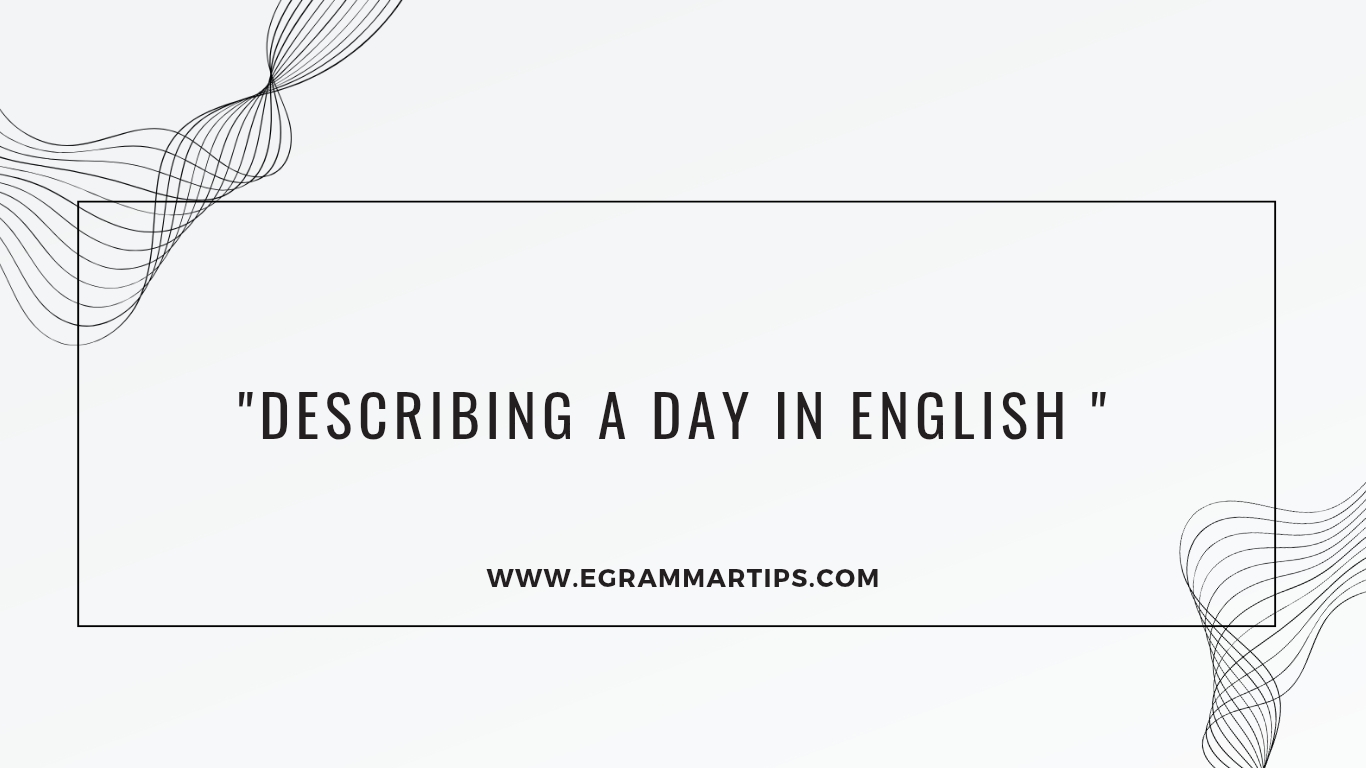
Describing your day in English requires proper sentence structure, tenses, and vocabulary. Here’s a detailed grammar lesson to help you express yourself clearly and correctly.
Table of Contents
Toggle1. Sentence Structure for Daily Routine
A well-formed sentence usually follows this structure:
Subject (Who?) + Verb (What action?) + Object/Details (What else?)
Example: “I wake up at 7 a.m.”
To make your sentences more interesting and detailed, use:
Adverbs (quickly, slowly, usually, always) – I usually wake up at 7 a.m.
Adjectives (busy, relaxing, exciting) – It was a busy day.
Prepositions (in, at, on, after, before) – I work in an office.
2. Using the Correct Tenses
When describing your day, you mostly use the present simple, past simple, and sometimes present continuous or future tenses
(a) Present Simple (Routine or Habit)
Use: To describe daily routines and habits.
Structure: Subject + Verb (base form) + Object
Examples:I wake up at 7 a.m.
She goes to work by bus.
We have lunch at noon.
(b) Present Continuous (Actions Happening Now)
Use: To describe what you are doing at the moment.
Structure: Subject + am/is/are + Verb (-ing)
Examples:
I am drinking coffee right now.
She is studying for her exam.
They are playing football.
(c) Past Simple (Finished Actions in the Past)
Use: To describe what you did earlier today or yesterday.
Structure: Subject + Verb (past form) + Object
Examples:
I woke up at 7 a.m. and had breakfast.
She went to the gym in the evening.
We watched a movie last night.
(d) Future Tenses (Plans for Later in the Day)
Use: To talk about plans for the evening or next day.
Structure:
Future Simple (will + verb) → I will call you later.
Going to (planned actions) → I am going to visit my friend tonight.
Present Continuous (for near future plans) → We are having dinner at 8 p.m.
3. Linking Words for a Natural Flow
To make your description smooth, use linking words:
First, then, after that, later, finally → for time order
Because, so, therefore → for reasons
But, however, although → for contrast
Also, in addition, besides → for adding more details
Example:”First, I woke up at 7 a.m. Then, I had breakfast. After that, I went to work. In the evening, I watched TV and finally went to bed at 10 p.m.”
4. Sample Description of a Day
Basic Version:
“I wake up at 7 a.m. and have breakfast. Then, I go to work and finish at 5 p.m. After that, I return home, have dinner, and watch TV. Finally, I go to bed at 10 p.m.”
Detailed Version (Using Tenses & Linking Words):
“Today, I woke up at 7 a.m. and had a cup of coffee. After that, I took a quick shower and got ready for work. At 8 a.m., I left home and arrived at the office by 9 a.m. Work was very busy, and I had a lot of meetings. At noon, I had lunch with my colleagues at a nearby café. In the evening, I went to the gym for an hour before heading home. After dinner, I watched a movie, and finally, I went to bed at 10:30 p.m. I was really tired but happy with my day.”
5. Common Grammar Mistakes and How to Fix Them
(a) Incorrect Use of Tenses
❌ I wake up at 7 a.m. and went to work.
✅ I wake up at 7 a.m. and go to work. (Present Simple)
✅ I woke up at 7 a.m. and went to work. (Past Simple)
(b) Wrong Prepositions
❌ I wake up in 7 a.m.
✅ I wake up at 7 a.m.
❌ I go in home at 6 p.m.
✅ I go home at 6 p.m.
(c) Forgetting Third-Person Singular (He/She/It)
❌ He wake up at 7 a.m.
✅ He wakes up at 7 a.m.
6. Practice Exercise: Describe Your Day
Try to write about your day using:
1. Present Simple (for routine)
2. Past Simple (for what you did today)
3. Future Tense (for evening plans)
Example Start:
“Every morning, I wake up at 6 a.m. and drink coffee. Today, I woke up late because I was tired. Tonight, I will go to bed early.”